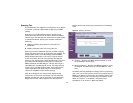
30
■ VLAN ID — ID of the configured VLAN (1-4094, no leading
zeroes).
■ Name — Name of the VLAN (1 to 32 characters).
■ Ports — Port identifier.
Trunking
Ports can be statically grouped into a trunk, also known as an
aggregated link under the IEEE 802.1ad standard. This increases
the bandwidth of a network connection and ensures fault
recovery. Trunking permits the connection of multiple ports to the
same remote device in order to achieve higher network
throughput.
Guidelines for creating Trunks
■ Any of the ports on the Switch can be used for creating a
trunk.
■ This switch can support a maximum of 4 trunks.
■ Each trunk may contain up to 8 members.
■ A port may only be a member of one trunk at any one time.
■ All ports in a trunk must be configured in an identical
manner, including communication mode (i.e., speed, duplex
mode and flow control).
Use the Trunking Create/Modify/Delete page to create, configure
or remove ports groups from trunks.
Figure 18 Trunking Screen
■ Trunk Number — Displays the number of the trunk.
■ Name — Allows you to label an interface. (Range: 1-64
characters)
■ Flow Control — Allows automatic or manual selection of flow
control.
■ Speed Duplex — Allows auto-negotiation to be enabled or
disabled. When auto-negotiation is disabled, you can force
the settings for speed, duplex mode and flow control.


















